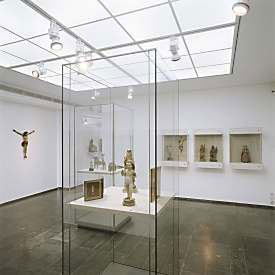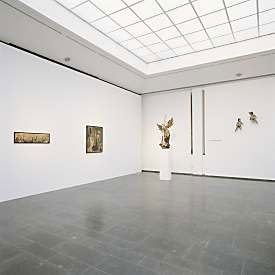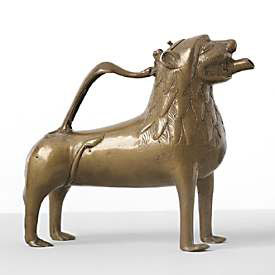2000 The Härle Donation
17 November 2000 to 16 May 2001
The Härle Donation
Reencounter with the Unknown – last part
In the 1920s and 1930s the lawyer and passionate art lover Carl Härle from Mülheim on the Ruhr compiled an extensive collection of medieval and baroque art. In doing so the self-taught art historian displayed exceptional connoisseurship. He tracked down excellent pieces of art in private collections, auctions and at art dealers, for example the altar formerly owned by the Rhenish aristocratic Palant family from around 1425, a Romanesque pouring vessel in the shape of a lion, or a Virgin lovingly playing with her child (Bavarian, Late Gothic). After the Church Council’s agreement to build Kolumba, the new building of the Diözesanmuseum, upon the ruins of the Late Gothic church destroyed in the war, 48 works of the renowned collection – sculptures of wood, clay and stone, bronze and enamel works as well as panel paintings and book illuminations – were given to the museum as a generous donation by the two youngest daughters of the collector, Maria (d. 1996) and Regina Härle. During the restoration works, which took place in recent years, astonishing discoveries were made, which, together with art historical expertise and new photographs of all objects, have been compiled to form an extensive catalogue for the exhibition. The catalogue also contains an interview with Regina Härle about her memories of her father and his passion for collecting. Due to supplemental loans of works owned by various branches of the family, we are able to show virtually the entire collection in this exhibition. On 8 October, Regina Härle, to whom the museum owes so much, died during the final preparations for the exhibition.
(Book publication sold out)
The Härle Donation
Reencounter with the Unknown – last part
In the 1920s and 1930s the lawyer and passionate art lover Carl Härle from Mülheim on the Ruhr compiled an extensive collection of medieval and baroque art. In doing so the self-taught art historian displayed exceptional connoisseurship. He tracked down excellent pieces of art in private collections, auctions and at art dealers, for example the altar formerly owned by the Rhenish aristocratic Palant family from around 1425, a Romanesque pouring vessel in the shape of a lion, or a Virgin lovingly playing with her child (Bavarian, Late Gothic). After the Church Council’s agreement to build Kolumba, the new building of the Diözesanmuseum, upon the ruins of the Late Gothic church destroyed in the war, 48 works of the renowned collection – sculptures of wood, clay and stone, bronze and enamel works as well as panel paintings and book illuminations – were given to the museum as a generous donation by the two youngest daughters of the collector, Maria (d. 1996) and Regina Härle. During the restoration works, which took place in recent years, astonishing discoveries were made, which, together with art historical expertise and new photographs of all objects, have been compiled to form an extensive catalogue for the exhibition. The catalogue also contains an interview with Regina Härle about her memories of her father and his passion for collecting. Due to supplemental loans of works owned by various branches of the family, we are able to show virtually the entire collection in this exhibition. On 8 October, Regina Härle, to whom the museum owes so much, died during the final preparations for the exhibition.
(Book publication sold out)



